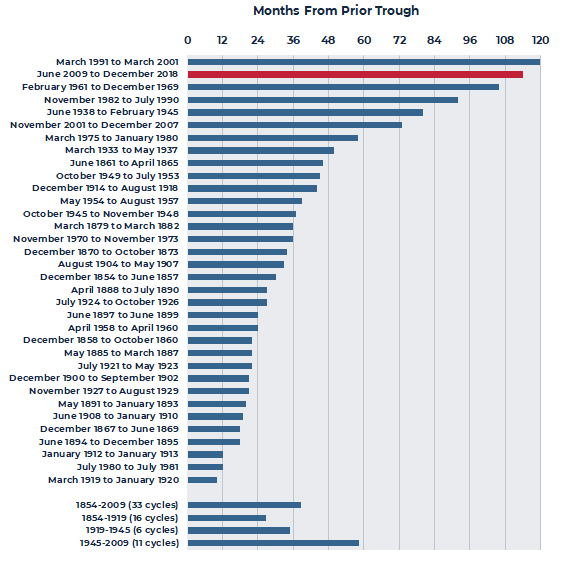If the current U.S. economic expansion continues past June 2019, this will officially become the longest expansion in the nation’s history, surpassing the 120-month expansion from March 1991 to March 2001. The recession dating committee of the National Bureau of Economic Research, the group tasked with officially defining U.S. business cycles, has identified 33 distinct periods of recessions and expansions beginning as far back as 1854 (see Figure 1). Interestingly, nine of the ten longest U.S. expansions have occurred since the creation of the Federal Reserve in 1913 and the establishment of a policy mandate designed to maintain full employment and, later, price stability as well as the advent of active (Keynesian) monetary policy during the 1930s.
Figure 1: Length of U.S. Economic Expansions
Source: National Bureau of Economic Research (NBER)
While each economic cycle is unique, there have been some common factors over time. Long economic expansions typically display myriad similarities in their later stages such as very low unemployment, accelerating wage growth and building inflationary pressures, which usually lead to generalized policy responses to dampen growth. Most often, these responses are found in monetary policy, typically manifested in changes in overnight lending rates and, more recently, expansion or contraction of central bank balance sheets. Interest rates, of course, influence large swathes of the economy by changing the borrowing cost for large capital items such as houses and automobiles while the balance sheet impact is largely one of dollar liquidity through the buildup or draw down of excess reserves in the banking system.
The information and opinions presented in this research piece have been prepared internally and/or obtained from sources which AEW believes to be reliable; however, AEW does not guarantee the accuracy, adequacy, or completeness of such information.


